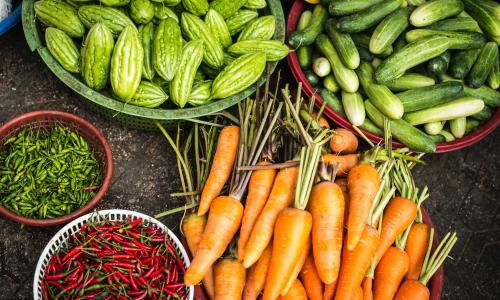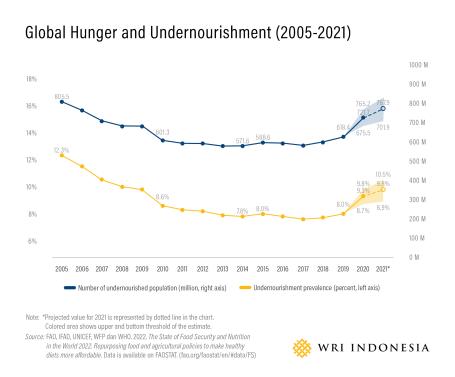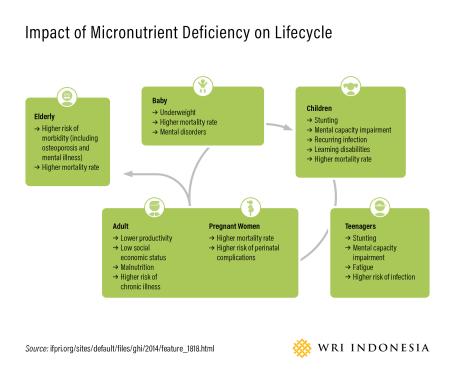
Preparing Against Hidden Hunger by Optimizing Local Food
This article was originally published on Kompas on December 16, 2022.
Hunger is often equated with the lack of food resources, even though the body's nutritional need should also be a factor. Looking at the aggregate availability of food as well as food consumption and calorie needs, FAO (2021) estimates that more than 700 million people in the world face hunger due to undernourishment every day.
Since 2018, there has been an increase in the number of people experiencing hunger and the increase has jumped sharply in 2020 and 2021. The main reason for this increase is the COVID-19 pandemic, which has made it increasingly difficult for people to access the food they need due to economic problems and a lack of supply.
Another indicator used to measure hunger is the Food Insecurity Experiences Scale (FIES), which is calculated through direct interviews with respondents on challenges in accessing food. This scale shows that 2.3 billion people in the world fall under the category of moderate or severe food insecurity. A total of 60 percent of the population is categorized into moderate food insecurity, which means they reduce the quality and quantity of their food or are unsure of their ability to obtain food due to economic problems. This condition poses the risks of malnutrition, stunting, micronutrient deficiencies, and adult obesity.

Interestingly, micronutrient deficiency, which is an issue in Indonesia, is included in the category of hidden hunger. Hidden hunger is a condition caused by undernourishment due to the lack of vitamins and mineral intake (micronutrient deficiency). The lack of vitamins and minerals that the body needs will lead to stunted growth in children and disruption in the body's vitality causing impaired physical growth, poor cognitive function, low resistance to infection, and degenerative and chronic diseases in old age. Hidden hunger is also covered in the targets of Sustainable Development Goals (SDGs) 2: "Zero Hunger", which is categorized in the calculation of moderate food insecurity.
Micronutrient deficiency is one of the triple burden of malnutrition in Indonesia, along with stunting and malnutrition. Despite a significant decline, a high number of cases continues to be recorded. The stunting rate in children under five in Indonesia remains relatively high, with a prevalence of 24.4 percent. Meanwhile, adult obesity (> 18 years) records a prevalence of 21.8 percent. This is worsened by the astronomical rate of anemia in pregnant women.
Why then should we pay special attention to hidden hunger? The indications for hidden hunger are not as visible as those for stunting or malnutrition, but the impact can be seen in every human life cycle.
The image below shows that hidden hunger can affect an individual’s growth and development in the womb with diverse consequences, ranging from the risk of stillbirth, malnutrition, stunting and productivity, and mental health issues. Without immediate action, this will lead to increased risks of various health problems, especially the risk of worsening the triple burden of malnutrition in Indonesia.

So how much of Indonesia's population is actually experiencing hidden hunger? Based on the estimation of the Professor of Nutrition, Faculty of Human Ecology, IPB, Prof. Drajat Martianto, 50 percent of Indonesia's population does not consume enough vegetables, fruit, nuts and animal protein. When compared to FIES data, the section of the population experiencing hidden hunger in Indonesia is estimated to remain below 14.4 million in 2020. Despite the discrepancy in numbers due to different accounting methodologies, such hidden hunger figure is concerning and certainly needs to be addressed.
What must be done immediately? Our current diet must be transformed to avoid hidden hunger by doubling the consumption of a variety of available foods such as vegetables, fruit, legumes and nuts and limiting animal protein intake. Increased vegetables, fruits and nuts consumption will certainly meet the human body’s vitamins and minerals requirements to avoid hidden hunger. The vegetables and fruits consumed also need to be based on the availability of local vegetables and fruits in each region.
Optimizing the consumption of fruit, vegetables and nuts in each region will help reduce fruit and vegetable loss in an extensive supply chain. Based on Indonesia's 2021 Food Loss and Food Waste report, unconsumed vegetables and fruit that become losses and waste reach 62.8 percent and 45.5 percent of the total domestic supply respectively. That means half of the domestic supply is wasted and cannot be consumed optimally to avoid hidden hunger. Optimizing the variety of local fruits and vegetables consumed can also increase public awareness through the government's #IsiPiringku campaign, which promotes a balanced and healthy diet. Campaigns can promote the importance of consuming fruits and vegetables in the portion recommended by this campaign, which is 50 percent of our plate contents at each meal. The campaign can be improved by promoting the consumption of local vegetables and fruits to reduce losses and food waste.
In addition, preserving forests and the biodiversity within them will help ensure the availability of food sources for the people. Currently, more than half of the human population consumes vegetables and fruits from the forest. Therefore, forest cover is associated with a greater variety of nutritious diets and increased consumption of vegetables and fruits.
To maintain forest sustainability, agricultural intensification methods for fruits and vegetables are an alternative for Indonesia. Through agricultural intensification, especially for vegetables and fruit, we can increase the supply of fruit and vegetables and maintain the sustainability of forests as fruit and vegetables providers. Increased productivity is hoped to increase access to vegetables and fruit for all levels of society.